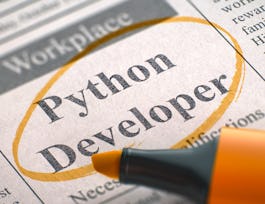In this course, learners will be introduced to the field of statistics, including where data come from, study design, data management, and exploring and visualizing data. Learners will identify different types of data, and learn how to visualize, analyze, and interpret summaries for both univariate and multivariate data. Learners will also be introduced to the differences between probability and non-probability sampling from larger populations, the idea of how sample estimates vary, and how inferences can be made about larger populations based on probability sampling.



Understanding and Visualizing Data with Python
This course is part of Statistics with Python Specialization



Instructors: Brenda Gunderson
Sponsored by IEM UEM Group
140,903 already enrolled
(2,650 reviews)
Recommended experience
What you'll learn
Properly identify various data types and understand the different uses for each
Create data visualizations and numerical summaries with Python
Communicate statistical ideas clearly and concisely to a broad audience
Identify appropriate analytic techniques for probability and non-probability samples
Skills you'll gain
Details to know

Add to your LinkedIn profile
9 assignments
See how employees at top companies are mastering in-demand skills

Build your subject-matter expertise
- Learn new concepts from industry experts
- Gain a foundational understanding of a subject or tool
- Develop job-relevant skills with hands-on projects
- Earn a shareable career certificate


Earn a career certificate
Add this credential to your LinkedIn profile, resume, or CV
Share it on social media and in your performance review

There are 4 modules in this course
In the first week of the course, we will review a course outline and discover the various concepts and objectives to be mastered in the weeks to come. You will get an introduction to the field of statistics and explore a variety of perspectives the field has to offer. We will identify numerous types of data that exist and observe where they can be found in everyday life. You will delve into basic Python functionality, along with an introduction to Jupyter Notebook. All of the course information on grading, prerequisites, and expectations are on the course syllabus and you can find more information on our Course Resources page.
What's included
11 videos7 readings2 assignments1 discussion prompt5 ungraded labs
In the second week of this course, we will be looking at graphical and numerical interpretations for one variable (univariate data). In particular, we will be creating and analyzing histograms, box plots, and numerical summaries of our data in order to give a basis of analysis for quantitative data and bar charts and pie charts for categorical data. A few key interpretations will be made about our numerical summaries such as mean, IQR, and standard deviation. An assessment is included at the end of the week concerning numerical summaries and interpretations of these summaries.
What's included
6 videos3 readings3 assignments1 discussion prompt6 ungraded labs
In the third week of this course on looking at data, we’ll introduce key ideas for examining research questions that require looking at more than one variable. In particular, we will consider both numerically and visually how different variables interact, how summaries can appear deceiving if you don’t properly account for interactions, and differences between quantitative and categorical variables. This week’s assignment will consist of a writing assignment along with reviewing those of your peers.
What's included
4 videos2 readings2 assignments1 peer review1 discussion prompt6 ungraded labs
In this week, you’ll spend more time thinking about where data come from. The highest-quality statistical analyses of data will always incorporate information about the process used to generate the data, or features of the data collection design. You’ll be exposed to important concepts related to sampling from larger populations, including probability and non-probability sampling, and how we can make inferences about larger populations based on well-designed samples. You’ll also learn about the concept of a sampling distribution, and how estimation of the variance of that distribution plays a critical role in making statements about populations. Finally, you’ll learn about the importance of reading the documentation for a given data set; a key step in looking at data is also looking at the available documentation for that data set, which describes how the data were generated.
What's included
12 videos10 readings2 assignments4 ungraded labs
Instructors

Offered by
Why people choose Coursera for their career




Learner reviews
2,650 reviews
- 5 stars
76.06%
- 4 stars
18.43%
- 3 stars
3.54%
- 2 stars
0.94%
- 1 star
1.01%
Showing 3 of 2650
Reviewed on Jun 2, 2020
Never have I come across a course half as interactive as this and it was a much needed confidence booster for a beginner like me. I look forward to completing the specialization : )
Reviewed on May 21, 2020
Excellent course materials, especially the videos, with content that is thoughtfully composed and carefully edited. Very good python training, great instructors, and overall great learning experience.
Reviewed on Mar 2, 2021
20 studying hours that helps me getting back to speed on manipulating the quantitative data in Pandas with different query conditions, powerful statistics and Sampling Distributions.
Recommended if you're interested in Data Science

University of Michigan

Rice University

University of Colorado Boulder

Open new doors with Coursera Plus
Unlimited access to 10,000+ world-class courses, hands-on projects, and job-ready certificate programs - all included in your subscription
Advance your career with an online degree
Earn a degree from world-class universities - 100% online
Join over 3,400 global companies that choose Coursera for Business
Upskill your employees to excel in the digital economy



